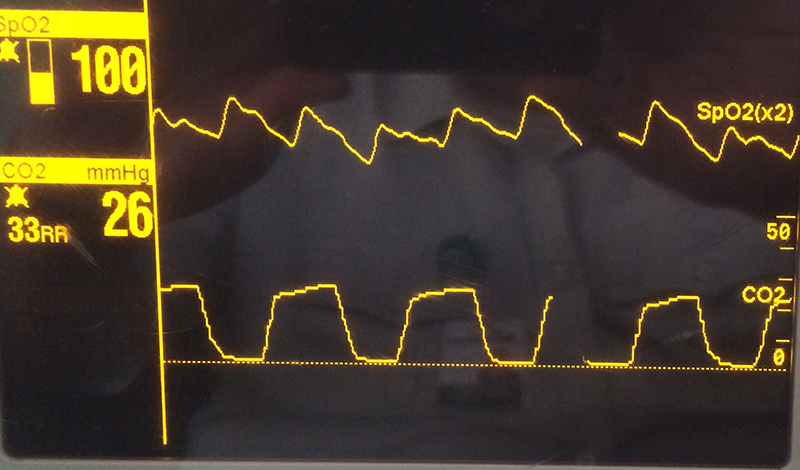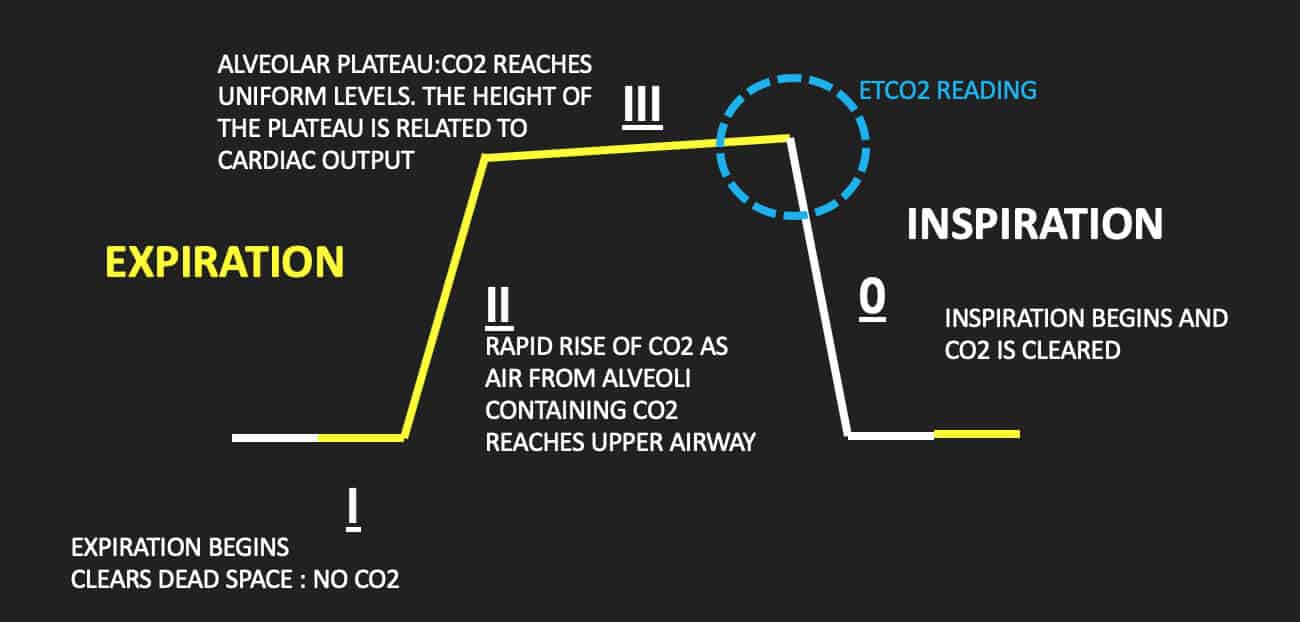end tidal co2 range low
More recently a large group of medical doctors from several American hospitals tested over 100 patients and wrote an article End-tidal. End-tidal carbon dioxide versus arterial carbon dioxide at different ranges of physiologic dead space.

How Capnography Can Be Used To Identify Sepsis Capnoacademy Capnoacademy
The researchers found that end-tidal CO2 could provide a highly sensitive predictor of return of spontaneous circulation during cardiopulmonary resuscitation MPR p791 Cantineau et al 1996.
. Maximum end-tidal carbon dioxide Et co 2 within 5 minutes of the onset of mechanical ventilation in the operating room OR. The median ETCO 2 value was 32 mmHg IQR 27 38 mmHg range 18-80 mmHg. Cardiac output and end-tidal carbon dioxide.
A low end-tidal CO2 may indicate poor perfusion hypovolemia or sepsis. In patients with a low calculated physiologic dead space to tidal volume ratio VdVt. Hypocapnia hypotension and hypertension during aneurysm occlusion in patients with an aneurysmal subarachnoid hemorrhage may lead to a poor prognosis but evidence for end-tidal carbon dioxide ET co 2 and mean arterial pressure MAP targets is lackingWithin the ranges of standardized treatment the authors aimed to study the association between hypocapnia Pa.
End-tidal carbon dioxide ETco 2 monitoring provides valuable information about CO 2 production and clearance ventilation. A At a physiologic dead space to tidal volume ratio VdVt 04 the correlation is very strong ρ 095. In hyperventilation the CO2 waveform becomes smaller and more frequent and the numeric reading falls below the normal range.
End-tidal carbon dioxide ETCO 2. The height of the capnography waveform accompanies this number on the monitor as well as the. Ensure proper rate approximately 100min Ensure proper depth with adequate releaserecoil of thorax 12 thorax or minimum 25 inches Persistently low EtCO.
Throughout the resuscitation end-tidal CO 2 was consistently in the 28-36 mmHg range during VFCPR. Since reduced breathing in the sick those with less than 20 s for the body oxygen test or more than 12 Lmin for minute ventilation at rest is done with increased respiratory frequency and reduced tidal volume they can get low etCO 2 numbers while in reality their alveolar and arterial CO2 will be increasing during the whole session eg 10-15 minutes. Thirty-nine patients referred to our sleep laboratory because of suspected SAS and ten normal subjects were studied.
The purpose of the present study was to determine the value of end-tidal CO2 EtCO2 in screening for sleep apneas. A number of studies have shown that expired CO2 concentration is closely related to cardiac output but that cardiac output was not controlled as an independent variable. Forty-six of 96 48 95 confidence interval CI 38 58 patients had abnormal ETCO 2 values including 37 39 95 CI 29 49 with low ETCO 2 levels and.
The number is called capnometry which is the partial pressure of CO 2 detected at the end of exhalation ranging between 35 - 45 mm Hg or 40 57 kPa. Measurement of a low ETCO 2 value 10 mmHg during CPR in an intubated patient suggests that the quality of chest compressions needs improvement. Although the normal range for CO2 should be between 35-45mmHg CO2 monitoring gives healthcare providers a lot more insight into what is going on with a patients condition.
The number is. The objective of the present study was to measure PETCO2 during well. Thus according to the relationship between ETCO2 and P a CO2.
Evidence suggests a persistently low ETco 2 value and a widened Paco 2-to-ETco 2 gradient during CPR are associated with poor outcomes. End-tidal carbon dioxide cannot be used to rule out severe injury in. End tidal CO 2 monitoring is represented as a number and a graph on a monitor.
The amount of CO2 at the end of exhalation or end-tidal CO2 ETCO2 is normally 35-45 mm HG. At the end of expiration gas sampled from the trachea should be alveolar gas and the CO 2 level will equate to the alveolar and therefore arterial CO2 in dogs and cats that dont have lung disease. The waveform is called capnograph and shows how much CO 2 is present at each phase of the respiratory cycle.
According to the book by Hockenberry and Wilson 2015 p 1140 normal values of ETCO2 are 30-43 mmHg which is slightly lower than arterial PaCO2 35-45mmHg. End-tidal clearance must be evaluated in the context of the patients perfusion status. In addition a low P a CO2 level is correlated with increased risk of cerebral edema in children with DKA.
End tidal co2 range cpr Wednesday March 2 2022 Edit. Thirty-nine patients referred to our sleep laboratory because of suspected SAS and ten normal subjects were studied. Box plot with data points overlaid.
End tidal normally 2-5 mmHg lower than arterial Comparing Arterial and End-tidal CO2 Review of Airway Confirmation Visualization Auscultation. Normal end tidal co2 range. Waveform and end -tidal carbon dioxide EtCO2 values.
End Tidal CO 2 sampling Ventilatory function minute ventilation decreases and therefore CO2 increases in a A dead space gasno CO2 B mixed. Dead-space ventilation results in ventilated alveoli with insufficient perfusion which leads to low ETco 2. The EtCO2 was measured using an infrared spectrometer POET designed for simultaneous measurement of CO2 and.
The hinges represent the first and third quartiles the notches represent the 95 confidence interval CI of the median and the whiskers extend to 15 interquartile range. This may result from such ventilatory problems as high mean airway pressure or inadequate exhalation time resulting in overdistention or from such circulatory problems as. In addition the partial pressure of end-tidal CO2 PETCO2 during extremely low cardiac output has not been reported.
A low end-tidal CO2 may indicate poor perfusion hypovolemia or sepsis.

Waveform Capnography In The Intubated Patient Emcrit Project

Etco2 Valuable Vital Sign To Assess Perfusion The Airway Jedi

Capnography Provides Bigger Physiological Picture To Maximize Patient Care Jems Ems Emergency Medical Services Training Paramedic Emt News

Exhaled Carbon Monoxide End Tidal Co2 And Peripheral Oxygen Saturation Download Table

End Tidal Capnography Can Be Useful For Detecting Diabetic Ketoacidosis Monitoring Copd Page 2 Of 4 Acep Now Page 2

Basic Capnography Interpretation Nuem Blog

3 Waveform Capnography Showing Changes In The End Tidal Carbon Dioxide Download Scientific Diagram

Exhaled Carbon Monoxide End Tidal Co2 And Peripheral Oxygen Saturation Download Table

Basic Capnography Interpretation Nuem Blog
Riding The Wave Of Capnography Understanding Etco2 Vetbloom Blog

Waveform Capnography In The Intubated Patient Emcrit Project

Waveform Capnography In The Intubated Patient Emcrit Project
Emdocs Net Emergency Medicine Educationcapnography In The Ed Emdocs Net Emergency Medicine Education

Reversible Causes Of Low Etco2 In Cpr Criticalcarenow
Riding The Wave Of Capnography Understanding Etco2 Vetbloom Blog

A Systematic Approach To Capnography Waveforms Jems Ems Emergency Medical Services Training Paramedic Emt News

Ems Assessment And Treatment Of Asthma 5 Things To Know Capnoacademy Capnoacademy
